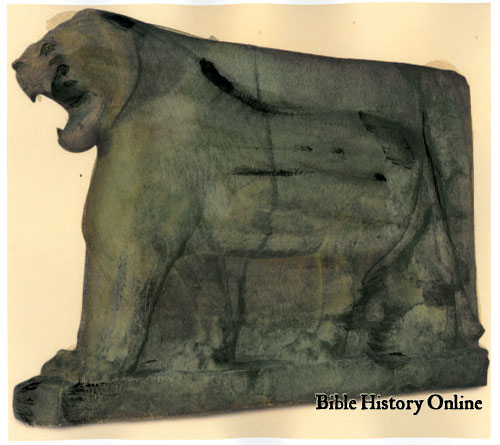Colossal Lion of Assyria

Could this 15-ton Lion of
War have been carved with the destruction of Israel in mind?
This gigantic roaring lion, once stood as part of a pair of lions at the entrance of an Assyrian temple dedicated to Ishtar, the goddess of warfare, and fertility.
The temple was adjoining the palace of King Ashurnasirpal II (reigned 883-859 BC. The temple was excavated by Henry Layard in 1849.
"...Where can we flee for help to be delivered from the king of Assyria: and how shall we escape?"
Isaiah 20:6
"He will raise a signal for a
nation from afar off, and whistle for it from the ends of the earth;
and lo, swiftly, speedily it comes."
Isaiah 5:26
Detailed Description of the Colossal Lion
Material - Limestone
Neo-Assyrian,
Reign of Ashurnasirpal II
Date: 883-859 BC
Width: 2.24 m
Height: 2.59 m
Nimrud (ancient Kalhu), northern Iraq
Excavated by: Henry Layard, 1849
Location: British Museum, London
Item: ANE 118895
Room: Room 6, Assyrian sculpture
British Museum Excerpt
Colossal statue of a lion
Guardian figure from the entrance to the Temple of Ishtar
This gigantic standing lion, roaring angrily, formed one of a pair carved half in the round which once flanked the entrance of a small temple dedicated to the goddess Ishtar, adjoining the palace of King Ashurnasirpal II (reigned 883-859 BC). The temple was excavated by Henry Layard in 1849.
The placing of figures of lions beside the doors of temples or the gates of cities was an ancient custom in Mesopotamia. Actual lions were common in the region and survived there until the nineteenth century.
The fifth leg is an artistic convention to enable the figure to be seen either from the side, walking, or from the front, standing. Compare this with the colossal statue of a winged human-headed bull from the palace of Ashurnasirpal II, also in The British Museum.
The lion is covered with a dedication in cuneiform, consisting of a prayer by Ashurnasirpal to a version of Ishtar called Sharrat-niphi, followed by a record of some of his achievements. Ishtar was one of the most important deities of Assyria. Here main cult centres were at Nineveh and Arbela. The lioness was her symbol as the goddess of fertility and warfare.
"The lion hath roared, who will not fear?" - Amos 3:8
Related Pages:
Head of a Roaring Lion - Assyria
Bible History Links - Biblical Archaeology : Assyria
Bible History Links - Ancient Near East : Art & Images 2
The
Striding Lion of Babylon
Archaeology of Ancient Assyria - Ancient Assyria
Bible History Links - Ancient Near East : Art & Images
HUNTING in
the Bible Encyclopedia - ISBE
International Standard Bible Encyclopedia - Calah
Assyria and Bible Prophecy - Nineveh Will Be Laid Waste
Bible History Links - Ancient Near East
Bible History Links - Ancient Near East : Ancient Texts
Read The Bible
- 1599 Geneva Bible (GNV)
- 21st Century King James Version (KJ21)
- American Standard Version (ASV)
- Amplified Bible (AMP)
- Amplified Bible, Classic Edition (AMPC)
- Authorized (King James) Version (AKJV)
- BRG Bible (BRG)
- Christian Standard Bible (CSB)
- Common English Bible (CEB)
- Complete Jewish Bible (CJB)
- Contemporary English Version (CEV)
- Darby Translation (DARBY)
- Disciples’ Literal New Testament (DLNT)
- Douay-Rheims 1899 American Edition (DRA)
- Easy-to-Read Version (ERV)
- English Standard Version (ESV)
- English Standard Version Anglicised (ESVUK)
- Evangelical Heritage Version (EHV)
- Expanded Bible (EXB)
- GOD’S WORD Translation (GW)
- Good News Translation (GNT)
- Holman Christian Standard Bible (HCSB)
- International Children’s Bible (ICB)
- International Standard Version (ISV)
- J.B. Phillips New Testament (PHILLIPS)
- Jubilee Bible 2000 (JUB)
- King James Version (KJV)
- Lexham English Bible (LEB)
- Living Bible (TLB)
- Modern English Version (MEV)
- Mounce Reverse Interlinear New Testament (MOUNCE)
- Names of God Bible (NOG)
- New American Bible (Revised Edition) (NABRE)
- New American Standard Bible (NASB)
- New American Standard Bible 1995 (NASB1995)
- New Catholic Bible (NCB)
- New Century Version (NCV)
- New English Translation (NET)
- New International Reader's Version (NIRV)
- New International Version - UK (NIVUK)
- New International Version (NIV)
- New King James Version (NKJV)
- New Life Version (NLV)
- New Living Translation (NLT)
- New Matthew Bible (NMB)
- New Revised Standard Version (NRSV)
- New Revised Standard Version Catholic Edition (NRSVCE)
- New Revised Standard Version, Anglicised (NRSVA)
- New Revised Standard Version, Anglicised Catholic Edition (NRSVACE)
- New Testament for Everyone (NTE)
- Orthodox Jewish Bible (OJB)
- Revised Geneva Translation (RGT)
- Revised Standard Version (RSV)
- Revised Standard Version Catholic Edition (RSVCE)
- The Message (MSG)
- The Voice (VOICE)
- Tree of Life Version (TLV)
- World English Bible (WEB)
- Worldwide English (New Testament) (WE)
- Wycliffe Bible (WYC)
- Young's Literal Translation (YLT)
Main Menu
- Ancient Assyrian Social Structure
- Ancient Babylonia
- Ancient Canaan During the Time of Joshua
- Ancient History Timeline
- Ancient Oil Lamps
- Antonia Fortress
- Archaeology of Ancient Assyria
- Assyria and Bible Prophecy
- Augustus Caesar
- Background Bible Study
- Bible
- Biblical Geography
- Fallen Empires - Archaeological Discoveries and the Bible
- First Century Jerusalem
- Glossary of Latin Words
- Herod Agrippa I
- Herod Antipas
- Herod the Great
- Herod's Temple
- High Priest's in New Testament Times
- Jewish Literature in New Testament Times
- Library collection
- Map of David's Kingdom
- Map of the Divided Kingdom - Israel and Judah
- Map of the Ministry of Jesus
- Matthew Henry Bible Commentary
- Messianic Prophecy
- Nero Caesar Emperor
- Online Bible Maps
- Paul's First Missionary Journey
- Paul's Second Missionary Journey
- Paul's Third Missionary Journey
- Pontius Pilate
- Questions About the Ancient World
- Tabernacle of Ancient Israel
- Tax Collectors in New Testament Times
- The Babylonian Captivity
- The Black Obelisk of Shalmaneser
- The Books of the New Testament
- The Court of the Gentiles
- The Court of the Women in the Temple
- The Destruction of Israel
- The Fall of Judah with Map
- The History Of Rome
- The Incredible Bible
- The Jewish Calendar in Ancient Hebrew History
- The Life of Jesus in Chronological Order
- The Life of Jesus in Harmony
- The Names of God
- The New Testament
- The Old Testament
- The Passion of the Christ
- The Pharisees
- The Sacred Year of Israel in New Testament Times
- The Samaritans
- The Scribes
Ancient Questions
- Why Do the Huldah Gates Appear Different in Ancient Replicas and Modern Photos?
- What Is the Origin of the Japanese and Chinese Peoples? A Biblical Perspective
- How did the ancient Greeks and Romans practice medicine and treat illnesses?
- What were the major contributions of ancient Babylon to mathematics and astronomy?
- How did the ancient Persians create and administer their vast empire?
- What were the cultural and artistic achievements of ancient India, particularly during the Gupta Empire?
- How did ancient civilizations like the Incas and Aztecs build their remarkable cities and structures?
- What were the major trade routes and trading practices of the ancient world?
- What was the role of slavery in ancient societies like Rome and Greece?
- How did the ancient Mayans develop their sophisticated calendar system?
Bible Study Questions
- Why Do Christians Celebrate Christmas?
- How Many Chapters Are There in the Bible?
- The Five Key Visions in the New Testament
- The 400-Year Prophecy: Unpacking Genesis 15 and the Journey of a People
- The Authorized (King James) Version (AKJV): Historical Significance, Translation Methodology, and Lasting Impact
- Exploring the English Standard Version (ESV): Its Aspects, Comparisons, Impact on Biblical Studies, and Church Use
- A Detailed Historical Analysis of Language Updates in the KJ21: Comparison with Other Versions
- A Detailed Historical Analysis of the American Standard Version (ASV): Comparison to the King James Version, Influence on Later Translations, and Evaluation of Strengths and Weaknesses
- A Detailed Historical Analysis of Amplifications in the Amplified Bible (AMP) and Its Comparison to Other Bible Translations
- Detailed Historical Analysis of the Amplified Bible Classic Edition (AMPC): Examples of Amplifications and Comparative Analysis with Other Bible Translations
About
Welcome to Free Bible: Unearthing the Past, Illuminating the Present! Step into a world where ancient history and biblical narratives intertwine, inviting you to explore the rich tapestry of human civilization.
Discover the captivating stories of forgotten empires, delve into the customs and cultures of our ancestors, and witness the remarkable findings unearthed by dedicated archaeologists.
Immerse yourself in a treasure trove of knowledge, where the past comes alive and illuminates our understanding of the present.
Join us on this extraordinary journey through time, where curiosity is rewarded and ancient mysteries await your exploration.
Recent posts
-

Why Discipleship Ministries Matter: How They Shape Churches and Communities
Discipleship ministries have traditionally played an important role in Christians' spiritual growth and the long-term viability of their churches. Chr... -

A Historical Journey of Health Insurance: From Ancient Mutual Aid to Modern Coverage
The modern form of health insurance, which is premium based, pooled risk financial coverage during illness is a relatively new development. But the th... -

Get a Crypto License in Poland - Secure, EU-Ready, and Backed by Prifinance Expertise
Expand your crypto business legally in the European Union with a crypto license in Poland under the MiCA framework. Poland has become one of the most ... -

Why Partnering with the Right Mobile App Development Company Can Make or Break Your Project
Why Partnering with the Right Mobile App Development Company Can Make or Break Your Project In today's hyperconnected world, your app is frequently yo... -

Lion Posters & Canvas Wall Art — The Complete Buyer’s & Styling Guide
Collection Spotlight Lion Posters — Wild, Regal Wall Art for Every Interior A single lion portrait can command a room. A pair of lions can change th...
